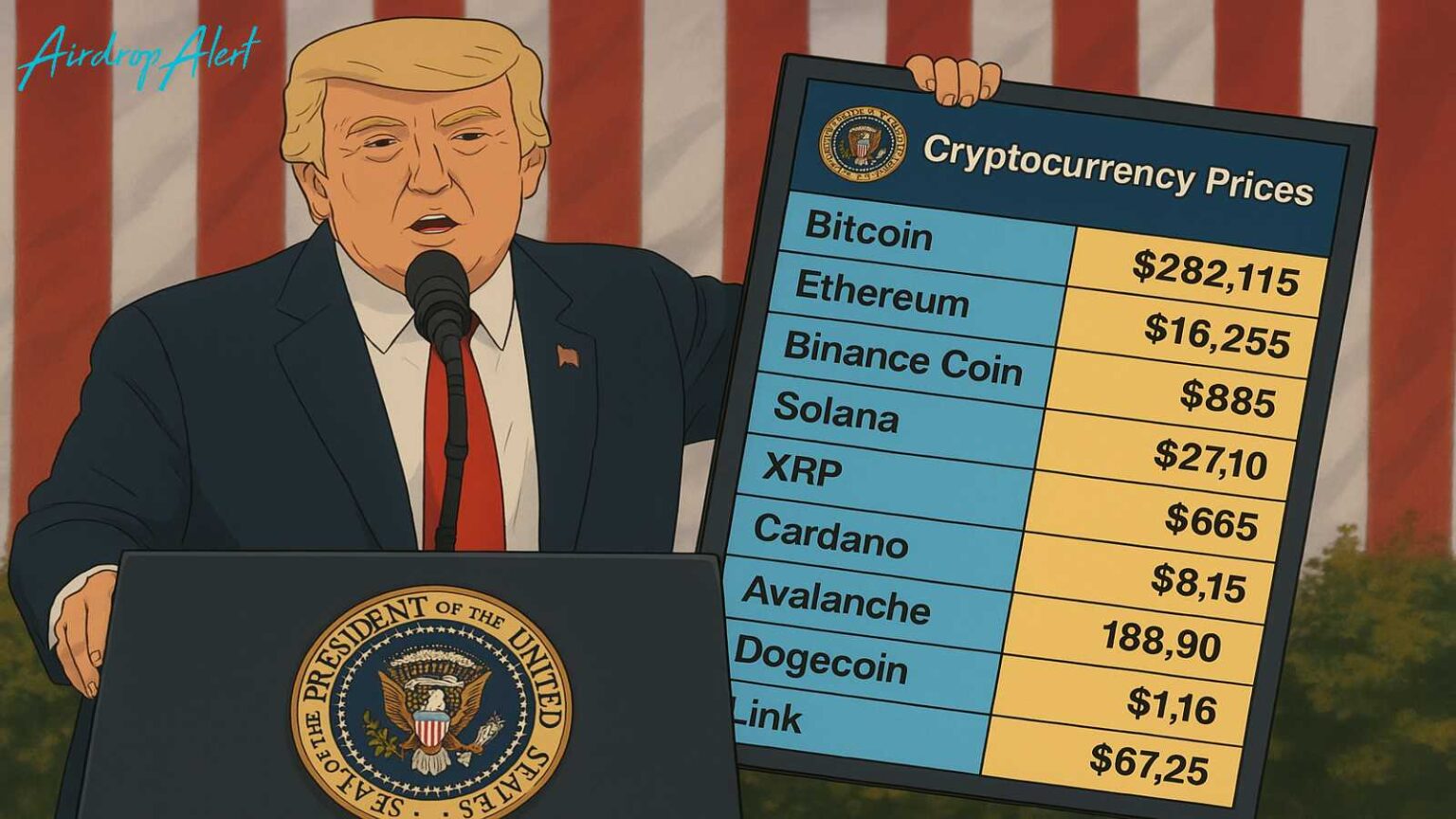The aftermath of U.S. President Donald Trump’s April 2 tariff announcement has sent shockwaves through global markets, from traditional stocks to cryptocurrencies. As investors grapple with the far-reaching effects of the tariffs, Bitcoin, stocks, and other assets have all taken a hit. But what does this mean for the future of Bitcoin and the broader economy? Let’s dive into how the new tariffs are reshaping the landscape and what’s next for the trade war.
The Immediate Impact of Trump’s Tariffs on Global Markets
Trump’s decision to implement sweeping tariffs has shaken both traditional and cryptocurrency markets. The baseline 10% tariff on all imports to the U.S., with even higher rates targeting countries like China (54%) and the European Union (20%), has raised concerns of a full-blown trade war. In the wake of this announcement, Bitcoin’s price slipped below $82,000, marking a 5.8% drop, while Solana fell 12% to a 13-month low of $113. Other cryptocurrencies, including Dogecoin and XRP, also saw significant declines.
The volatility in the market was not confined to cryptocurrencies. U.S. stock markets also took a hit, with the S&P 500 dropping by 4%, the Nasdaq plunging by 5.1%, and the Dow Jones nearing correction territory. The combination of these losses has left investors uneasy, as they now face the uncertain ramifications of retaliatory measures and potential global economic slowdowns.

A Trade War Brewing: What’s Next?
As expected, China quickly expressed its displeasure with Trump’s tariffs, promising retaliation. European Commission President Ursula Von Der Leyen also warned of countermeasures if talks with the U.S. fail. These escalating tensions are raising fears of a trade war that could exacerbate inflation and hurt economic growth worldwide.
The tariffs, the largest since the 1930s, have made investors nervous. The uncertainty is not only affecting stocks but also weighing heavily on the cryptocurrency market. In response, traders have sought “further protection against downward moves,” indicating a shift toward more stable investments. Governments are already showing their replies, with counter tariffs or other negotiation requests,

The tariffs’ impact on the crypto market was felt immediately. Bitcoin initially surged to $88,500, but the rally was short-lived, and the price dropped back to $83,073, marking a 2% decline over 24 hours. Other cryptocurrencies followed suit, with Ethereum and Solana both experiencing significant losses.
The Growing Fear: A Market in “Extreme Fear”
The fear and uncertainty stemming from Trump’s tariff announcement have resulted in a sharp drop in the Crypto Fear and Greed Index, which plummeted to 25, signaling “Extreme Fear” across the market. This significant decline reflects the broader market sentiment, as investors weigh the potential long-term effects of the tariffs on economic stability and global trade.

According to crypto data provider CoinGlass, the overall crypto market cap decreased by 4%, falling to $2.7 trillion. The sell-off also led to $514 million worth of liquidations within 24 hours, with $290 million arising from long positions. This reflects a nervous market looking for safety amid growing geopolitical risks.
In general, these fear indicators are usually good buy signals. Buy when others are fearful.
Study our trading guides to learn the right times to buy BTC
A Trade War and Bitcoin’s Path Forward

As the trade war intensifies, Bitcoin faces heightened risks. The key level to watch is $91,000. If Bitcoin can close above this level, it may signal a bullish reversal. However, if the price falls below the $79,000-$80,000 range, the first major support level to watch is $71,000.
Bitcoin’s volatility in the wake of Trump’s tariffs is not surprising. Cryptocurrencies are often considered speculative assets, and their value can be heavily influenced by macroeconomic events like trade wars. The higher-than-expected tariffs have sparked concern, with Bitcoin’s price falling by 8.5% on April 3, while U.S. stocks managed to recover slightly.
We know one man is buying this dip. And even tho his comment is a joke, it is the truth.

As for a short-term trade, I’m personally watching the $80.3k area, for the CME gap to catch a little bounce.
A Weakened Dollar and the Impact on Bitcoin
In the aftermath of the tariffs, the U.S. dollar has weakened against several major currencies, including the euro, the yen, and the Swiss franc. This has prompted investors to flock to safe-haven assets, further impacting the dollar’s strength. The euro, for example, surged by 2.4% to $1.1109, hitting its highest level in six months. The Japanese yen and Swiss franc also saw gains, further undermining confidence in the dollar.
As the dollar weakens, Bitcoin could become more attractive as an alternative store of value. This potential shift could help Bitcoin recover if inflation continues to rise and the U.S. dollar remains under pressure. However, the trade war’s continued escalation could also dampen investor confidence in both traditional markets and cryptocurrencies.

The Long-Term Outlook: What’s Next for Bitcoin?
While the immediate aftermath of Trump’s tariffs has been volatile, the long-term outlook for Bitcoin and other cryptocurrencies remains uncertain. The global economic effects of the trade war will play a major role in shaping the market’s future. If the trade war leads to a recession or further inflationary pressures, Bitcoin may see increased demand as a hedge against economic instability.
On the other hand, if the tariffs lead to a prolonged economic slowdown, the resulting loss of confidence in both traditional and crypto markets could weigh heavily on Bitcoin’s price. The next few months will be crucial in determining whether Bitcoin can maintain its position above key support levels or if it will experience a significant downturn.
The Bigger Picture: Global Trade and Economic Growth
As the trade war unfolds, it’s important to remember that the implications extend far beyond the crypto market. The tariffs are part of a broader shift in U.S. trade policy, one that aims to protect American industries and reduce reliance on foreign imports. However, these moves come with significant risks, including retaliatory measures from other countries and potential disruptions to global supply chains.

The impact of the tariffs on global economic growth remains uncertain. While Trump asserts that the measures will lead to lower consumer prices in the long run, the immediate effects have been negative, with inflationary concerns rising and economic growth forecasts being revised downward. The possibility of a prolonged trade war could further strain the global economy, affecting everything from consumer goods to technological advancements.
Final Thoughts: Navigating the Trade War Aftermath
The aftermath of Trump’s April 2 tariff announcement has left markets in turmoil. With Bitcoin, stocks, and the global economy all feeling the pressure, investors are watching closely to see how the trade war will unfold. While the future remains uncertain, one thing is clear: the impact of these tariffs will be felt across financial markets for some time.
For Bitcoin, the key levels to watch are $91,000 for potential bullish signals and $71,000 for support. As the trade war continues, Bitcoin’s role as a store of value could become more important, but its path forward will depend on how the global economic situation develops. Whether the trade war escalates or de-escalates, Bitcoin’s volatility will remain a key factor in its future. So far, there are no tariffs on crypto yet. Keep that in mind when you go to sleep with your bags intact.
Stay tuned for updates as the trade war continues to shape the global economic landscape.
If you enjoyed this blog, check out our recent charts of 5 popular altcoins, including $BNB, $ADA, and $LINK.
As always, don’t forget to claim your bonus below on Bybit. See you next time!



